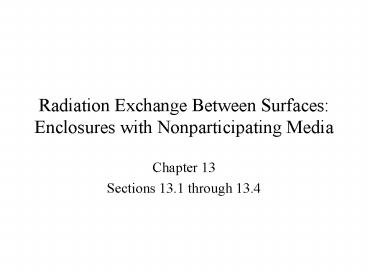Radiation Exchange Between Surfaces: Enclosures with Nonparticipating Media - PowerPoint PPT Presentation
1 / 26
Title:
Radiation Exchange Between Surfaces: Enclosures with Nonparticipating Media
Description:
Enclosures consist of two or more surfaces that envelop a region of space ... Problem 13.93: Assessment of ceiling radiative properties for an ice rink ... – PowerPoint PPT presentation
Number of Views:174
Avg rating:3.0/5.0
Title: Radiation Exchange Between Surfaces: Enclosures with Nonparticipating Media
1
Radiation Exchange Between SurfacesEnclosures
with Nonparticipating Media
- Chapter 13
- Sections 13.1 through 13.4
2
Basic Concepts
Basic Concepts
- Enclosures consist of two or more surfaces that
envelop a region of space - (typically gas-filled) and between which
there is radiation transfer.
Virtual, as well as real, surfaces
may be introduced to form an enclosure.
- A nonparticipating medium within the enclosure
neither emits, absorbs, - nor scatters radiation and hence has no
effect on radiation exchange - between the surfaces.
- Each surface of the enclosure is assumed to be
isothermal, opaque, diffuse - and gray, and to be characterized by uniform
radiosity and irradiation.
3
View Factor Integral
The View Factor (also Configuration or Shape
Factor)
4
View Factor Relations
View Factor Relations
- Reciprocity Relation.
With
- Summation Rule for Enclosures.
For example,
- Two-Dimensional Geometries (Table 13.1)
An Infinite Plane and a Row of Cylinders
5
View Factor Relations (cont)
- Three-Dimensional Geometries (Table 13.2).
For example,
Coaxial Parallel Disks
6
Blackbody Enclosure
Blackbody Radiation Exchange
net rate at which
radiation leaves surface i due to its interaction
with j
or net rate at which surface j gains radiation
due to its interaction with i
- Net radiation transfer from surface i due to
exchange with all (N) - surfaces of an enclosure
7
General Enclosure Analysis
General Radiation Analysis for Exchange between
the N Opaque, Diffuse, Gray Surfaces of an
Enclosure
- Alternative expressions for net radiative
- transfer from surface i
8
General Enclosure Analysis (cont)
- Equating Eqs. (3) and (4) corresponds to a
radiation balance on surface i
which may be represented by a radiation network
of the form
9
General Enclosure Analysis (cont)
- Methodology of an Enclosure Analysis
- Evaluate all of the view factors appearing in
the resulting equations.
10
Two-Surface Enclosures
Two-Surface Enclosures
- Simplest enclosure for which radiation exchange
is exclusively between two - surfaces and a single expression for the rate
of radiation transfer may be - inferred from a network representation of the
exchange.
11
Two-Surface Enclosures (cont)
- Special cases are presented in Table 13.3.
For example,
- Large (Infinite) Parallel Plates
- Note result for Small Convex Object in a Large
Cavity.
12
Radiation Shield
Radiation Shields
- Consider use of a single shield in a
two-surface enclosure, such as that associated
with - large parallel plates
Note that, although rarely the case, emissivities
may differ for opposite surfaces of the shield.
13
Radiation Shield (cont)
- Radiation Network
- The foregoing result may be readily extended to
account for multiple shields - and may be applied to long, concentric
cylinders and concentric spheres, - as well as large parallel plates.
14
Reradiating Surfaces
The Reradiating Surface
- Approximated by surfaces that are well
insulated on one side and for which - convection is negligible on the opposite
(radiating) side.
- Three-Surface Enclosure with a Reradiating
Surface
15
Reradiating Surfaces (cont)
16
Multimode Effects
Multimode Effects
- In an enclosure with conduction and convection
heat transfer to or from - one or more surfaces, the foregoing treatments
of radiation exchange may - be combined with surface energy balances to
determine thermal conditions.
- Consider a general surface condition for which
there is external heat addition - (e.g., electrically), as well as conduction,
convection and radiation.
17
Problem Furnace in Spacecraft Environment
Problem 13.88 Power requirement for a
cylindrical furnace with two reradiating
surfaces and an opening to large surroundings.
18
Problem Furnace in Spacecraft Environment (cont)
19
Problem Furnace in Spacecraft Environment (cont)
20
Problem Furnace in Spacecraft Environment (cont)
21
Problem Furnace in Spacecraft Environment (cont)
22
Problem 13.93
Problem 13.93 Assessment of ceiling radiative
properties for an ice rink in terms of ability
to maintain surface temperature above the
dewpoint.
23
Problem 13.93 (cont)
24
Problem 13.93 (cont)
Since the ceiling panels are diffuse-gray, ? ?.
25
Problem 13.93 (cont)
26
Problem 13.93 (cont)

